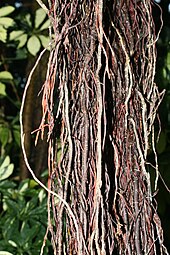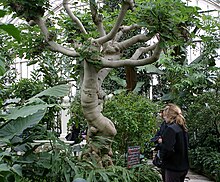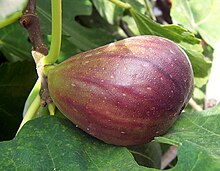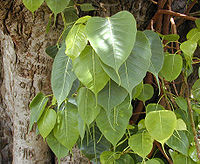Ficus
| Fig trees Temporal range:
| |
|---|---|

| |
| Sycamore fig,Ficus sycomorus | |
| Scientific classification | |
| Kingdom: | Plantae |
| Clade: | Tracheophytes |
| Clade: | Angiosperms |
| Clade: | Eudicots |
| Clade: | Rosids |
| Order: | Rosales |
| Family: | Moraceae |
| Tribe: | Ficeae Dumort. |
| Genus: | Ficus L. |
| Species | |
|
About 800, seetext | |
| Synonyms[1] | |
| |
Ficus(/ˈfaɪkəs/[2]or/ˈfiːkəs/[3][4]) is agenusof about 850speciesof woodytrees,shrubs,vines,epiphytesandhemiepiphytesin thefamilyMoraceae.Collectively known asfig treesorfigs,they are native throughout thetropicswith a few species extending into the semi-warmtemperatezone. Thecommon fig(F. carica) is a temperate species native to southwest Asia and theMediterraneanregion (from Afghanistan to Portugal), which has been widely cultivated from ancient times for itsfruit,also referred to as figs. The fruit of most other species are also edible though they are usually of only local economic importance or eaten asbushfood.However, they are extremely important food resources for wildlife. Figs are also of considerable cultural importance throughout the tropics, both as objects of worship and for their many practical uses.
Description
[edit]


Ficusis apantropicalgenus of trees, shrubs, and vines occupying a wide variety ofecological niches;most areevergreen,but some deciduous species are found in areas outside of the tropics and to higher elevations.[5]Fig species are characterized by their uniqueinflorescenceand distinctivepollination syndrome,which uses wasp species belonging to the familyAgaonidaefor pollination.
Specific identification of many of the species can be difficult, but members of the genusFicusare relatively easy to recognize. Many haveaerial rootsand a distinctive shape or habit, and their fruits distinguish them from other plants. The fruit ofFicusis aninflorescenceenclosed in an urn-like structure called asyconium,which is lined on the inside with the fig's tiny flowers that develop into multiple ovaries on the inside surface.[6]In essence, the fig fruit is a fleshy stem with multiple tiny flowers that fruit and coalesce.
The unique figpollinationsystem, involving tiny, highly specific wasps, known asfig waspsthat enter viaostiolethese subclosed inflorescences to both pollinate and lay their own eggs, has been a constant source of inspiration and wonder to biologists.[7]Notably, three vegetative traits together are unique to figs. All figs present a white to yellowishlatex,some in copious quantities; the twig shows pairedstipules—or circular scars if the stipules have fallen off; the lateral veins at the base of the leaf are steep, forming a tighter angle with the midrib than the other lateral veins, a feature referred to as "triveined".
Currentmolecular clockestimates indicate thatFicusis a relatively ancient genus, being at least 60 million years old,[7]and possibly as old as 80 million years. The main radiation ofextantspecies, however, may have taken place more recently, between 20 and 40 million years ago.
Some better-known species that represent the diversity of the genus include, alongside thecommon fig,whose fingeredfig leafis well known in art andiconography:theweeping fig(F. benjamina), ahemiepiphytewith thin, tough leaves on pendulous stalks adapted to itsrain foresthabitat; the rough-leavedsandpaper figsfrom Australia; and thecreeping fig(F. pumila), a vine whose small, hard leaves form a dense carpet of foliage over rocks or garden walls.
Moreover, figs with different plant habits have undergoneadaptive radiationin differentbiogeographicregions, leading to very high levels ofAlpha diversity.In the tropics,Ficuscommonly is the most species-rich plant genus in a particular forest. In Asia, as many as 70 or more species can co-exist.[8]Ficusspecies richnessdeclines with an increase in latitude in both hemispheres.[9][10]
A description of fig tree cultivation is set out inIbn al-'Awwam's 12th-century agricultural work titled,Book on Agriculture.[11]
Ecology
[edit]Figs arekeystone speciesin manytropical forestecosystems.Their fruit are a key resource for somefrugivoresincludingfruit bats,and primates including:capuchin monkeys,langurs,gibbonsandmangabeys.They are even more important forbirdssuch asAsian barbets,pigeons,hornbills,fig-parrotsandbulbuls,which may almost entirely subsist on figs when these are in plenty. ManyLepidopteracaterpillarsfeed on fig leaves, for example severalEuploeaspecies (crow butterflies), theplain tiger(Danaus chrysippus), thegiant swallowtail(Papilio cresphontes), thebrown awl(Badamia exclamationis), andChrysodeixis eriosoma,ChoreutidaeandCopromorphidaemoths.Thecitrus long-horned beetle(Anoplophora chinensis), for example, has larvae that feed onwood,including that of fig trees; it can become apestin fig plantations. Similarly, thesweet potato whitefly(Bemisia tabaci) is frequently found as a pest on figs grown aspotted plantsand is spread through the export of these plants to other localities. For a list of other diseases common to fig trees, seeList of foliage plant diseases (Moraceae).
Fig fruit and reproduction system
[edit]


Many fig species are grown for their fruits, though onlyFicus caricais cultivated to any extent for this purpose.[citation needed][disputed–discuss]A fig "fruit" is a type ofmultiple fruitknown as asyconium,derived from an arrangement of many small flowers on an inverted, nearly closed receptacle. The many small flowers are unseen unless the fig is cut open.[citation needed]
The fruit typically has a bulbous shape with a small opening (theostiole) at the outward end that allows access topollinators.The flowers are pollinated byvery small waspssuch asPegoscapusthat crawl through the opening in search of a suitable place to lay eggs. Without this pollinator service fig trees could not reproduce by seed. In turn, the flowers provide a safe haven and nourishment for the next generation of wasps. This accounts for the frequent presence of wasp larvae in the fruit, and has led to acoevolutionaryrelationship. Technically, a fig fruit proper would be only one of the many tiny matured, seed-bearinggynoeciafound inside one fig – if you cut open a fresh fig, individual fruit will appear as fleshy "threads", each bearing a single seed inside. The genusDorstenia,also in the fig family (Moraceae), exhibits similar tiny flowers arranged on a receptacle but in this case the receptacle is a more or less flat, open surface.[citation needed]
Fig plants can bemonoecious(hermaphrodite)[clarification needed]orgynodioecious(hermaphrodite and female).[12]Nearly half of fig species are gynodioecious, and therefore have some plants with inflorescences (syconium) with long styled pistillate flowers, and other plants with staminate flowers mixed with short styled pistillate flowers.[13]The long-styled flowers tend to prevent wasps from laying their eggs within the ovules, while the short-styled flowers are accessible for egg laying.[14]
All the native fig trees of the American continent are hermaphrodites, as well as species likeIndian banyan(F. benghalensis),weeping fig(F. benjamina),Indian rubber plant(F. elastica),fiddle-leaved fig(F. lyrata),Moreton Bay fig(F. macrophylla),Chinese banyan(F. microcarpa),sacred fig(F. religiosa) andsycamore fig(F. sycomorus).[15]The common fig (Ficus carica) is a gynodioecious plant, as well aslofty figor clown fig (F. aspera),Roxburgh fig(F. auriculata),mistletoe fig(F. deltoidea),F. pseudopalma,creeping fig(F. pumila) and related species. The hermaphrodite common figs are called "inedible figs" or "caprifigs"; in traditional culture in theMediterranean regionthey were considered food forgoats(Capra aegagrus). In the female fig trees, the male flower parts fail to develop; they produce the "'edible figs".Fig waspsgrow in common fig caprifigs but not in the female syconiums because the female flower is too long for the wasp to successfully lay her eggs in them. Nonetheless, the wasp pollinates the flower with pollen from the caprifig it grew up in. In many situations, the wasp pollinator is unable to escape and dies within the fruit. When the wasp dies, it is broken down by enzymes (Ficain) inside the fig. Fig wasps are not known to transmit any diseases harmful to humans.
When a caprifig ripens, another caprifig must be ready to be pollinated. In temperate climes, wasps hibernate in figs, and there are distinct crops. Caprifigs have three crops per year; common figs have two.[16]The first crop (breba) is larger and juicier, and usually eaten fresh.[16]In cold climates the breba crop is often destroyed by spring frosts.[17]Someparthenocarpiccultivarsof common figs do not require pollination at all, and will produce a crop of figs (albeitsterile) in the absence of caprifigs and fig wasps.
Depending on the species, each fruit can contain hundreds or even thousand of seeds.[18]Figs can be propagated by seeds, cuttings, air-layering or grafting. However, as with any plant, figs grown from seed are not necessarily genetically identical to the parent and are only propagated this way for breeding purposes.
Mutualism with the pollinating fig wasps
[edit]
Each species of fig is pollinated by one or a few specialised wasp species, and therefore plantings of fig species outside of their native range results in effectively sterile individuals. For example, inHawaii,some 60 species of figs have been introduced, but only four of the wasps that fertilize them, so only those species of figs produce viable seeds there and can becomeinvasive species.This is an example ofmutualism,in which each organism (fig plant andfig wasp) benefit each other, in this case reproductively.[citation needed]
The intimate association between fig species and their wasp pollinators, along with the high incidence of a one-to-one plant-pollinator ratio have long led scientists to believe that figs and wasps are a clear example ofcoevolution.Morphological and reproductive behavior evidence, such as the correspondence between fig and wasp larvae maturation rates, have been cited as support for this hypothesis for many years.[19]Additionally, recent genetic and molecular dating analyses have shown a very close correspondence in the character evolution andspeciationphylogenies of these two clades.[7]
According to meta-analysis of molecular data for 119 fig species 35% (41) have multiple pollinator wasp species. The real proportion is higher because not all wasp species were detected.[20]On the other hand, species of wasps pollinate multiple host fig species.[21]Molecular techniques, likemicrosatellitemarkers and mitochondrial sequence analysis, allowed a discovery of multiple genetically distinct,crypticwasp species. Not all these cryptic species are sister taxa and thus must have experienced a host fig shift at some point.[22]These cryptic species lacked evidence of geneticintrogressionorbackcrossesindicating limited fitness forhybridsand effectivereproductive isolationandspeciation.[22]
The existence of cryptic species suggests that neither the number of symbionts northeir evolutionary relationshipsare necessarily fixed ecologically.[22]While the morphological characteristics that facilitate the fig-wasp mutualisms are likely to be shared more fully in closer relatives, the absence of unique pairings would make it impossible to do a one-to-one tree comparison and difficult to determine cospeciation.[citation needed]
Systematics
[edit]With over 800 species,Ficusis by far the largest genus in the Moraceae, and is one of the largest genera of flowering plants currently described.[23]The species currently classified withinFicuswere originally split into several genera in the mid-1800s, providing the basis for a subgeneric classification when reunited into one genus in 1867. This classification put functionallydioeciousspecies into four subgenera based on floral characters.[24]In 1965,E. J. H. Cornerreorganized the genus on the basis of breeding system, uniting these four dioecious subgenera into a single dioecious subgenusFicus.Monoeciousfigs were classified within the subgeneraUrostigma,PharmacosyceaandSycomorus.[25]
This traditional classification has been called into question by recentphylogeneticstudies employing genetic methods to investigate the relationships between representative members of the various sections of each subgenus.[7][24][26][27][28]Of Corner's original subgeneric divisions of the genus, onlySycomorusis supported as monophyletic in the majority of phylogenetic studies.[7][24][27]Notably, there is no clear split between dioecious and monoecious lineages.[7][24][26][27][28]One of the two sections ofPharmacosycea,a monoecious group, form a monophyletic clade basal to the rest of the genus, which includes the other section ofPharmacosycea,the rest of the monoecious species, and all of the dioecious species.[28]These remaining species are divided into two main monophyletic lineages (though the statistical support for these lineages is not as strong as for the monophyly of the more derived clades within them). One consists of all sections ofUrostigmaexcept for sectionUrostigma s. s..The other includes sectionUrostigma s. s.,subgenusSycomorus,and the species of subgenusFicus,though the relationships of the sections of these groups to one another are not well resolved.[7][28]
Selected species
[edit]As of April 2024, there are 880 acceptedFicusspecies according toPlants of the World Online.[1]
SubgenusFicus
[edit]- Ficus amplissimaSm.– bat fig
- Ficus caricaL.– common fig
- Ficus daimingshanensisChang
- Ficus deltoideaJack– mistletoe fig
- Ficus erectaThunb.– Japanese fig
- Ficus fulvaReinw. ex Blume
- Ficus grossularioidesBurman f.– white-leaved fig
- Ficus neriifoliaSm.
- Ficus palmataForssk.
- Ficus pandurataHance
- Ficus simplicissimaLour.(synonymFicus hirtaVahl)
- Ficus trilobaBuch.-Ham. ex Voigt
SubgenusPharmacosycea
[edit]- Ficus crassiusculaStandl.
- Ficus gigantosyceDugand
- Ficus insipidaWilld.
- Ficus lacunataKvitvik
- Ficus maximaMill.
- Ficus mutabilisBureau
- Ficus nervosaHeyne ex Roth
- Ficus pulchellaSchott
- Ficus yoponensisDesv.
SubgenusSycidium
[edit]- Ficus andamanicaCorner
- Ficus asperaG.Forst.
- Ficus assamicaMiq.
- Ficus bojeriBaker
- Ficus capreifoliaDelile
- Ficus coronataSpin– creek sandpaper fig
- Ficus fraseriMiq.– shiny sandpaper fig
- Ficus heterophyllaL.f.
- Ficus laterifloraVahl
- Ficus montanaBurm.f.– oakleaf fig
- Ficus oppositaMiq.– sweet sandpaper fig
- Ficus phaeosyceK.Schum. & Lauterb.
- Ficus tinctoriaG.Forst.– dye fig
- Ficus ulmifoliaLam.
- Ficus wassaRoxb.
- Ficus parietalis
- Ficus sinuata
- Ficus hampelas
SubgenusSycomorus
[edit]- Ficus auriculataLour.– Roxburgh fig
- Ficus bernaysiiKing
- Ficus brusiiWeiblen– lowland form of breadfruit,kapiak
- Ficus dammaropsisDiels– highland breadfruit,kapiak
- Ficus fistulosaBlume
- Ficus hispidaL.
- Ficus notaMerr.–tibig
- Ficus pseudopalmaBlanco
- Ficus racemosaL.– cluster fig
- Ficus septicaBurm.f.– hauli tree
- Ficus sycomorusL., 1753– sycamore fig (Africa)
- Ficus variegataBlume
SubgenusSynoecia
[edit]The following species[29]are typically spreading or climbinglianas:
- Ficus hederaceaRoxb.[30]
- Ficus pantonianaKing[31]– climbing fig
- Ficus pumilaL.[32]– creeping fig
- Ficus pumilavar.awkeotsang(Makino) Corner– jelly fig
- Ficus punctataThunb.[33]
- Ficus sagittataJ. König exVahl
- Ficus sarmentosaBuch.-Ham. ex Sm.
- Ficus trichocarpaBlume
- Ficus villosaBlume[34]
- Ficus abutilifoliaMiq.
- Ficus albert-smithiiStandl.
- Ficus altissimaBlume
- Ficus amazonicaMiq.
- Ficus americanaAubl.
- Ficus aripuanensisBerg & Kooy
- Ficus arpazusaCarauta and Diaz– Brazil[35]
- Ficus aureaNutt.– Floridastrangler fig
- Ficus beddomeiKing–thavital
- Ficus benghalensisL.– Indian banyan
- Ficus benjaminaL.– weeping fig[36]
- Ficus binnendijkiiMiq.
- Ficus bizanaeHutch. & Burtt-Davy
- Ficus blepharophyllaVázquez Avila
- Ficus broadwayiUrb.
- Ficus burtt-davyiHutch.
- Ficus calyptrocerasMiq.
- Ficus castellvianaDugand
- Ficus catappifoliaKunth & Bouché
- Ficus citrifoliaMill.– short-leaved fig
- Ficus consociataBl.
- Ficus cordataThunb.
- Ficus costataAit.[36]
- Ficus crassipesF.M.Bailey– round-leaved banana fig
- Ficus craterostomaMildbr. & Burret
- Ficus cyathistipulaWarb.
- Ficus cyclophylla(Miq.) Miq.
- Ficus dendrocidaKunth
- Ficus depressaBl.
- Ficus destruensF.White
- Ficus drupaceaThunb.
- Ficus elasticaHornem.– rubber plant
- Ficus exasperataVahl.
- Ficus faulknerianaBerg
- Ficus fergusonii(King) T.B.Worth. ex Corner
- Ficus glaberrimaBlume
- Ficus glumosaDelile
- Ficus greiffianaDugand
- Ficus hirsutaSchott
- Ficus ilicinaMiq.
- Ficus kerkhoveniiValeton[37]– Johore fig
- Ficus kurziiKing
- Ficus luschnathianaMiq.
- Ficus ingensMiq.
- Ficus krukoviiStandl.
- Ficus lacorBuch.-Ham.
- Ficus lapathifoliaMiq.
- Ficus lauretanaVázquez Avila
- Ficus luteaVahl
- Ficus lyrataWarb.– fiddle-leaved fig
- Ficus maclellandiiKing– Alii fig
- Ficus macrophyllaDesf. ex Pers.– Moreton Bay fig
- Ficus malacocarpaStandl.
- Ficus mariaeBerg, Emygdio & Carauta
- Ficus mathewsiiMiq.
- Ficus matizianaDugand
- Ficus microcarpaL.– Chinese banyan
- Ficus muellerianaBerg
- Ficus natalensisHochst.– Natal fig
- Ficus obliquaG.Forst.– small-leaved fig
- Ficus obtusifoliaKunth
- Ficus pakkensisStandl.
- Ficus pallidaVahl
- Ficus panurensisStandl.
- Ficus pertusaL.f.
- Ficus petiolarisKunth
- Ficus pisocarpaBl.
- Ficus platypodaCunn.– desert fig
- Ficus pleurocarpaDC.– banana fig
- Ficus politaVahl
- Ficus religiosaL.– sacred fig
- Ficus roraimensisBerg
- Ficus rubiginosaDesf.– Port Jackson fig
- Ficus rumphiiBlume
- Ficus salicifoliaVahl– willow-leaved fig
- Ficus sansibaricaWarb.
- Ficus schippiiStandl.
- Ficus schultesiiDugand
- Ficus schumacheriGriseb.
- Ficus sphenophyllaStandl.
- Ficus stuhlmanniiWarb.
- Ficus subcordataBl.
- Ficus subpisocarpaGagnep.
- Ficus subpuberulaCorner
- Ficus sumatranaMiq.
- Ficus superbaMiq.
- Ficus superbavar.henneana(Miq.) Corner
- Ficus thonningiiBlume
- Ficus trichopodaBaker
- Ficus trigonaL.f.
- Ficus trigonataL.
- Ficus triradiataCorner– red-stipule fig
- Ficus ursinaStandl.
- Ficus velutinaWilld.
- Ficus verruculosaWarb.
- Ficus virensAiton– white fig
- Ficus virensvar.sublanceolata(Miq.) Corner– sour fig
- Ficus watkinsianaF.M.Bailey– Watkins' fig
Unknown subgenus
[edit]Uses
[edit]The wood of fig trees is often soft and thelatexprecludes its use for many purposes. It was used to makemummycasketsinAncient Egypt.Certain fig species (mainlyF. cotinifolia,F. insipidaandF. padifolia) are traditionally used inMesoamericato producepapel amate(Nahuatl:āmatl).Mutuba(F. natalensis) is used to producebarkclothin Uganda.Pou(F. religiosa) leaves' shape inspired one of the standardkbach rachana,decorative elements in Cambodian architecture.Indian banyan(F. benghalensis) and the Indian rubber plant, as well as other species, have use inherbalism.[citation needed]The inner bark of an unknown type of wild fig, locally known asurú,was once used by theMoré peopleof Bolivia to produce a fibrous cloth used for clothing.[38]
Figs have figured prominently in some human cultures. There is evidence that figs, specifically thecommon fig(F. carica) and sycamore fig (Ficus sycomorus), were among the first – if not the very first – plant species that were deliberately bred for agriculture in the Middle East, starting more than 11,000 years ago. NinesubfossilF. caricafigs dated to about9400–9200 BCEwere found in the earlyNeolithicvillageGilgal I(in theJordan Valley,13 km, or 8.1 mi, north ofJericho). These were aparthenogenetictype and thus apparently an early cultivar. This find predates the first known cultivation ofgrainin the Middle East by many hundreds of years.[39]
Cultivation
[edit]Numerous species of fig are found in cultivation in domestic and office environments, including:[40]
- F. carica,common fig – hardy to −10 °C (14 °F). Shrub or small tree which can be grown outdoors in mild temperate regions, producing substantial harvests of fruit. Many cultivars are available.
- F. benjamina,weeping fig, ficus – hardy to 5 °C (41 °F). Widely used as an indoor plant for the home or the office. It benefits from the dry, warm atmosphere of centrally-heated interiors, and can grow to substantial heights in a favoured position. Several variegated cultivars are available.
- F. elastica,rubber plant – hardy to 10 °C (50 °F): widely cultivated as a houseplant; several cultivars with variegated leaves
- F. lyrata,fiddle-leaf fig – hardy to 10 °C (50 °F)
- F. maclellandii– hardy to 5 °C (41 °F)
- F. microcarpa,Indian laurel – hardy to 10 °C (50 °F)
- F. pumila,creeping fig – hardy to 1 °C (34 °F)
- F. rubiginosa,Port Jackson fig – hardy to 10 °C (50 °F)
Cultural and spiritual significance
[edit]Fig trees have profoundly influenced culture through several religious traditions. Among the more famous species are thesacred figtree (Pipal, bodhi, bo, or po,Ficus religiosa) and otherbanyanfigs such asFicus benghalensis.The oldest living plant of known planting date is aFicus religiosatree known as theSri Maha Bodhiplanted in the temple atAnuradhapura,Sri Lanka by King Tissa in 288 BCE. The common fig is one of two significant trees inIslam,and there is asurain Quran named "The Fig" orAt-Tin(سوره تین). In Asia, figs are important inBuddhismandHinduism.InJainism,the consumption of any fruit belonging to this genus is prohibited.[41]TheBuddhais traditionally held to have foundbodhi(enlightenment) while meditating for 49 days under asacred fig.[42]The same species wasAshvattha,the "world tree"of Hinduism. ThePlaksa Pra-sravanawas said to be a fig tree between the roots of which theSarasvati Riversprang forth; it is usually held to be a sacred fig but more probably isFicus virens.According to theKikuyu people,sacrifices to Ngai were performed under a sycomore tree (Mũkũyũ) and if one was not available, a fig tree (Mũgumo) would be used. The common fig tree is cited in theBible,where in Genesis 3:7,Adam and Evecover their nakedness with fig leaves. The fig fruit is also one of thetraditional crops of Israel,and is included in the list of food found in the Promised Land, according to the Torah (Deut.8). Jesus cursed a fig tree for bearing no fruit (Mark 11:12–14). The fig tree was sacred in ancientGreeceandCyprus,where it was a symbol offertility.[citation needed]
-
Leaves of the sacred fig (Ficus religiosa)
-
Fig tree roots overgrowing a sandstone Buddha statue, nearWat Maha ThatinAyutthaya province,Thailand
-
Ficus tree in front ofSarkaradevi Temple,Kerala,India
List of famous fig trees
[edit]- Ashvattha– theworld treeofHinduism,held to be a supernaturalF. religiosa
- Bodhi tree– aF. religiosa
- Charybdis Fig TreeofHomer'sOdyssey,presumably aF. carica
- Curtain Fig Tree– aF. virens
- Ficus Ruminalis– aF. carica
- Plaksa– another supernatural fig in Hinduism; usually identified asF. religiosabut is probablyF. virens
- Santa Barbara's Moreton Bay Fig Tree– aF. macrophylla
- Sri Maha Bodhi– anotherF. religiosa,planted in 288 BCE, the oldest human-planted tree on record
- The Barren Fig Tree– Matthew 21:19 of theChristian Bible,Jesusput a curse on the treeand used this as an example for believers of the promise of the power faith in the only true God.
- The Great Banyan– aF. benghalensis,aclonal colonyand once the largest organism known
- Vidurashwatha– "Vidura's Sacred Fig Tree ", a village in India named after a famousF. religiosathat until recently stood there
- Wonderboom– the largest fig tree in Pretoria, South Africa, which has grown very large, through self-layering(limbs laying in the ground take root).
Citations
[edit]- ^ab"FicusTourn. ex L. "Plants of the World Online.Royal Botanic Gardens, Kew.Retrieved22 April2024.
- ^"ficus".Merriam-Webster Dictionary.Merriam-Webster.Retrieved2023-06-18.
- ^Sunset Western Garden Book.Sunset Books. 1995. pp. 606–607.ISBN978-0-37603-851-7.
- ^"ficus".CollinsDictionary.HarperCollins.
- ^Halevy, Abraham H. (1989).Handbook of Flowering Volume 6 of CRC Handbook of Flowering.CRC Press. p. 331.ISBN978-0-8493-3916-5.Retrieved2009-08-25.
- ^"Ficus: The Remarkable Genus Of Figs".Archived fromthe originalon 2009-12-11.Retrieved2021-05-16.
- ^abcdefgRønstedet al.(2005).
- ^Harrison (2005).
- ^van Noort & van Harten (2006).
- ^Berg & Hijmann (1989).
- ^Ibn al-'Awwam, Yaḥyá(1864).Le livre de l'agriculture d'Ibn-al-Awam (kitab-al-felahah)(in French). Translated by J.-J. Clement-Mullet. Paris: A. Franck. pp. 277–281 (ch. 7 - Article 25).OCLC780050566.(pp.277–281 (Article XXV)
- ^Armstrong, Wayne P; Disparti, Steven (4 April 1998)."A Key to Subgroups of Dioecious* (Gynodioecious) Figs Based On Fig Wasp/Male Syconium Pollination Patterns".Wayne's Word.Archived fromthe originalon 2012-02-02.Retrieved2012-01-05.
- ^Friis, Ib; Balslev, Henrik (2005).Plant diversity and complexity patterns: local, regional, and global dimensions.Kgl. Danske Videnskabernes Selskab. p. 472.ISBN978-87-7304-304-2.
- ^Valdeyron, Georges; Lloyd, David G. (June 1979). "Sex Differences and Flowering Phenology in the Common Fig, Ficus carica L.".Evolution.33(2): 673–685.doi:10.2307/2407790.JSTOR2407790.PMID28563939.
- ^Berg & Corner (2005).
- ^abSinha, K.K. (2003). "FIGS".Encyclopedia of Food Sciences and Nutrition.pp. 2394–2399.doi:10.1016/B0-12-227055-X/00463-6.ISBN978-0-12-227055-0.
- ^California Rare Fruit Growers, Inc. (1996):FigArchived2020-10-31 at theWayback Machine.Retrieved November 1, 2008.
- ^"The Weird Sex Life of the Fig"(PDF).Ray's Figs.Retrieved2012-01-05.
- ^Machado, C. A.; Jousselin, E.; Kjellberg, F.; Compton, S. G.; Herre, E. A. (7 April 2001)."Phylogenetic relationships, historical biogeography and character evolution of fig-pollinating wasps".Proceedings of the Royal Society B: Biological Sciences.268(1468): 685–694.doi:10.1098/rspb.2000.1418.PMC1088657.PMID11321056.
- ^Yang, Li-Yuan; Machado, Carlos A.; Dang, Xiao-Dong; Peng, Yan-Qiong; Yang, Da-Rong; Zhang, Da-Yong; Liao, Wan-Jin (February 2015)."The incidence and pattern of copollinator diversification in dioecious and monoecious figs".Evolution.69(2): 294–304.doi:10.1111/evo.12584.PMC4328460.PMID25495152.
- ^Machado, C. A.; Robbins, N.; Gilbert, M. T. P.; Herre, E. A. (3 May 2005)."Critical review of host specificity and its coevolutionary implications in the fig/fig-wasp mutualism".Proceedings of the National Academy of Sciences.102(Supplement 1): 6558–6565.Bibcode:2005PNAS..102.6558M.doi:10.1073/pnas.0501840102.PMC1131861.PMID15851680.
- ^abcMolbo, D.; Machado, C.A.; Sevenster, J.G.; Keller, L.; Herre, E.A. (24 April 2003)."Cryptic species of fig-pollinating wasps: Implications for the evolution of the fig-wasp mutualism, sex allocation, and precision of adaptation".Proceedings of the National Academy of Sciences.100(10): 5867–5872.Bibcode:2003PNAS..100.5867M.doi:10.1073/pnas.0930903100.PMC156293.PMID12714682.
- ^Judd, W.S.; Campbell, C.S.; Kellogg, E.A.; Stevens, P.F.; Donoghue, M.J. (2008).Plant Systematics: A phylogenetic approach(3rd ed.). Sunderland (Massachusetts): Sinauer Associates.ISBN978-0-87893-407-2.
- ^abcdWeiblen, G.D. (2000)."Phylogenetic relationships of functionally dioeciousFicus(Moraceae) based on ribosomal DNA sequences and morphology "(PDF).American Journal of Botany.87(9): 1342–1357.doi:10.2307/2656726.JSTOR2656726.PMID10991904.Retrieved2018-04-22.
- ^Corner, E.J.H.(1965)."Check-list ofFicusin Asia and Australasia with keys to identification ".The Gardens' Bulletin Singapore.21(1): 1–186.Retrieved5 Feb2014– via biodiversitylibrary.org.
- ^abHerre, E.; Machado, C.A.; Bermingham, E.; Nason, J.D.; Windsor, D.M.; McCafferty, S.; Van Houten, W.; Bachmann, K. (1996). "Molecular phylogenies of figs and their pollinator wasps".Journal of Biogeography.23(4): 521–530.Bibcode:1996JBiog..23..521H.doi:10.1111/j.1365-2699.1996.tb00014.x.
- ^abcJousselin, E.; Rasplus, J.-Y.; Kjellberg, F. (2003). "Convergence and coevolution in a mutualism: evidence from a molecular phylogeny of Ficus".Evolution; International Journal of Organic Evolution.57(6): 1255–1269.doi:10.1554/02-445.PMID12894934.S2CID1962136.
- ^abcdRønstedet al.(2008).
- ^Berg (2003).
- ^Berg (2003),p. 552.
- ^Berg (2003),p. 554.
- ^Berg (2003),p. 553.
- ^Berg (2003),pp. 565.
- ^Berg (2003),pp. 553–554.
- ^Carauta & Diaz (2002),pp. 38–39.
- ^abvan Noort, S.; Rasplus, J.Y. (2020)."SubsectionConosycea".Figweb: figs and fig wasps of the world.Retrieved11 August2019.
- ^Joseph Lai; Angie Ng; Chuah Ai Lin; Marilyn Cheng (12 September 2002)."Significant Trees and Shrubs in Changi".Retrieved2012-01-05.
- ^Castedo, Luis D. Leigue (1957).El Itenez Selvaje(PDF)(in Spanish). La Paz: Ministerio de Educación. p. 9, 16, 19, 23.
- ^Kislev, Hartmann & Bar-Yosef (2006).
- ^Brickell, Christopher, ed. (2008).The Royal Horticultural Society A-Z Encyclopedia of Garden Plants.United Kingdom: Dorling Kindersley. p. 448.ISBN9781405332965.
- ^Tukol, T.K.(1980).Compendium of Jainism.Prasaranga: Karnatak University. p. 206.
- ^"The Bodhi Tree: Uniting all Worlds".Buddhists.org.Retrieved17 January2020.
General references
[edit]- Berg, C.C. (28 November 2003)."Flora Malesiana Precursor for the Treatment of Moraceae 4:FicussubgenusSynoecia".Blumea.48(3): 551–571.doi:10.3767/000651903X489546.
- Berg, C.C.; Hijmann, M.E.E. (1989). "Chapter 11:Ficus".In R.M. Polhill (ed.).Flora of Tropical East Africa.pp. 43–86.
- Berg, C.C.; Corner, E.J.H. (2005).Flora malesiana. Series I, Seed plants. Volume 17. Part 2, Moraceae (Ficus).Leiden: National herbarium Nederland, Universiteit Leiden branch.ISBN978-9-07123-661-7.OCLC492578589.
- Carauta, Pedro; Diaz, Ernani (2002).Figueiras no Brasil.Rio de Janeiro: Editora UFRJ.ISBN978-85-7108-250-2.
- Condit, Ira J(1969).Ficus: the exotic species.University of California, Division of Agricultural Sciences.OCLC1086743649.
- Denisowski, Paul (2007)."Fig".Chinese–English Dictionary.RetrievedNovember 1,2008.
- Harrison, Rhett D (2005)."Figs and the diversity of tropical rain forests"(PDF).BioScience.55(12): 1053–1064.doi:10.1641/0006-3568(2005)055[1053:FATDOT]2.0.CO;2.Archived fromthe original(PDF)on 2021-02-24.Retrieved2008-11-01.
- Kislev, Mordechai E.; Hartmann, Anat; Bar-Yosef, Ofer (2006). "Early Domesticated Fig in the Jordan Valley".Science.312(5778): 1372–1374.Bibcode:2006Sci...312.1372K.doi:10.1126/science.1125910.PMID16741119.S2CID42150441.Supporting Online Material
- Kislev, Mordechai E.; Hartmann, Anat; Bar-Yosef, Ofer (2006). "Response to Comment on" Early Domesticated Fig in the Jordan Valley "".Science.314(5806): 1683b.Bibcode:2006Sci...314.1683K.doi:10.1126/science.1133748.PMID17170278.S2CID84471716.
- Lev-Yadun, Simcha; Ne'eman, Gidi; Abbo, Shahal; Flaishman, Moshe A (2006). "Comment on" Early Domesticated Fig in the Jordan Valley "".Science.314(5806): 1683a.Bibcode:2006Sci...314.1683L.doi:10.1126/science.1132636.PMID17170278.S2CID45767896.
- Lewington, Anna; Parker, Edward (1999).Ancient trees: Trees that live for 1000 years.London: Collins & Brown.ISBN978-18-5585-704-9.
- Rønsted, Nina; Weiblen, George D.; Cook, James M.; Salamin, Nicholas; Machado, Carlos A.; Savoainen, Vincent (2005)."60 million years of co-divergence in the fig-wasp symbiosis".Proceedings of the Royal Society B: Biological Sciences.272(1581): 2593–2599.doi:10.1098/rspb.2005.3249.PMC1559977.PMID16321781.
- Rønsted, N; Weiblen, G.D.; Clement, W.L.; Zerega, N.J.C.; Savolainen, V. (2008)."Reconstructing the phylogeny of figs (Ficus, Moraceae) to reveal the history of the fig pollination mutualism"(PDF).Symbiosis.45.ISSN0334-5114.
- Shanahan, M.; Compton, S. G.; So, Samson; Corlett, Richard (2001). "Fig-eating by vertebrate frugivores: a global review".Biological Reviews.76(4): 529–572.doi:10.1017/S1464793101005760.PMID11762492.S2CID27827864.Electronic appendices
- van Noort, Simon; van Harten, Antonius (2006)."The species richness of fig wasps (Hymenoptera: Chalcidoidea: Agaonidae, Pteromalidae) in Yemen".Fauna of Arabia.22:449–472.Retrieved2013-01-01.
External links
[edit]- Figweb—Major reference site for the genusFicus
- World checklist of Ficus species from the Catalogue of Life,845 species supplied by M. Hassler's World Plants.
- Video: Interaction of figs and fig wasps—Multi-award-winning documentary
- Fruits of Warm Climates: Fig
- BBC: Fig fossil clue to early farming
Video



